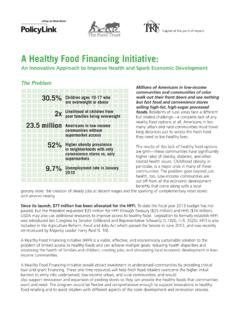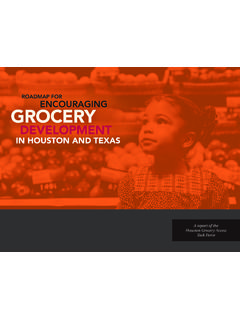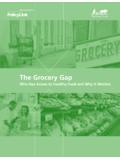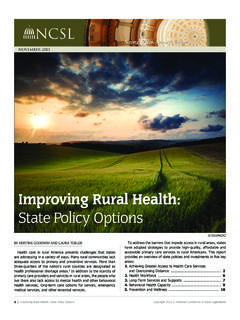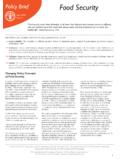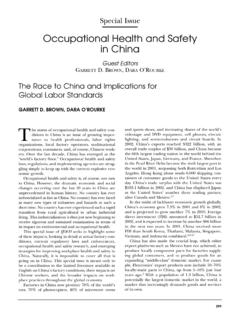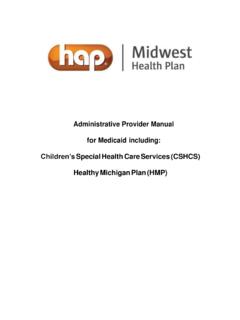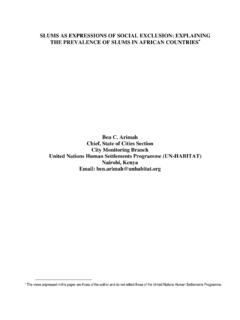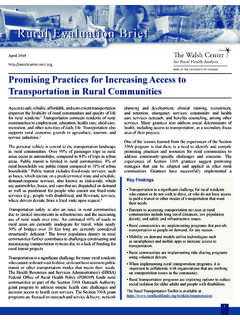Transcription of Find this report online at www.policylink.org.
1 Find this report online at 2013 by PolicyLinkAll rights by: Leslie YangCover photo courtesy of: courtesy of: PolicyLink is a national research and action institute advancing economic and social equity by Lifting Up What Works .The Food Trust, founded in 1992, is a nonpro t organization working to ensure that everyone has access to affordable, nutritious food. Judith Bell, MPAG abriella Mora, MPHErin Hagan, MBA, PhDVictor Rubin, MCP, PhDAllison Karpyn, PhD3 PolicyLinkAccess to Healthy Food and Why It MattersThe Food TrustTable of Contents4 Preface6 Introduction9 Findings19 Implications for policy and Research21 Appendix 22 References35 AcknowledgmentsPolicyLink4 Access to Healthy Food and Why It MattersThe Food TrustThe nation is abuzz with talk about good, healthy food, but for far too many people, and especially for those living in low-income communities and communities of color, healthy food is simply out of reach.
2 Finding quality fresh food means either traveling significant distances or paying exorbitant prices for wilting vegetables and overripe fruit. With these burdens, it is no surprise that these same communities face the highest risks of obesity, diabetes, and other preventable food-related health challenges. Yet, these are the very communities that are driving the nation s population growth and upon whom the country s future will depend. What will America s future be like if we do not fix this problem and end these disparities?In recognition of this, PolicyLink and The Food Trusta have been working together over the past five years to advance policies to help entre-preneurs and food retailers build or expand stores in underserved communities. Bringing grocery stores to low-income underserved areas creates a healthier food environment that supports making healthier choices: having easy, regular access to grocery stores or other food markets that sell fruits, vegetables, produce, and other staples at affordable prices is necessary to eat the well-a In most of this work, we have partnered with The Reinvestment Fund.
3 Rounded, nutritious diet essential for good health. Supermarkets and other retail outlets that sell hea-lthy foods are also major contributors to strong, local economies. Supermarkets, for example, are often economic anchors that draw in the foot traffic to support additional stores. They not only create many local jobs, but also foster other commercial development and breathe new life into neighborhoods that have been disinvested for decades. Successful advocacy by hundreds of organi-zations working to promote equity, health, entre-preneurship, and community development has helped bring over $1 billion in resources to healthy food access projects across the country through the federal Healthy Food Financing Initiative and similar efforts in more than 10 states and localities.
4 We have proudly helped to spark and support a virtual explosion of innovative healthy food retail projects in a vast number of urban, suburban, and rural low-income , of course, has been essential to both understanding the problem and developing effective solutions. And the research community has been thoroughly engaged with this issue. Over the past three years, at least 170 studies more than in the previous two decades have been published. These studies have examined what Preface5 PolicyLinkAccess to Healthy Food and Why It MattersThe Food Trustfactors affect access to healthy food and its impact on individual and community report provides a current picture of the state of the research on food access, following up on our 2010 report , The Grocery Gap: Who Has Access to Healthy Food and Why It Matters.
5 The presence of so many new and diverse innovations in healthy food retailing has provided researchers with more opportunities to examine the relationship between the food environments in which people live and their diets, as well as the relationship between food retailing and community economic development. The recent material also reflects researchers grow-ing intentions and capacities to measure change over time in terms of better access to healthy food. While much progress is being made to develop new models of food retailing that serve communities previously left out, the evidence continues to suggest that many families are underserved and that the problem is most pronounced for residents of low-income communities and communities of color. The research indicates that poor access to healthy food corresponds with poor nutrition and that new healthy food retail contributes to community economic development in tangible, positive ways.
6 Working together, we have seen that local leaders have the power to make a real difference. Leaders in many communities are crafting sustainable and authentic solutions to the grocery gap, creating healthier communities, and contributing to the nation s health and well-being. We have also seen how supportive policy can generate solutions in communities with the impetus coming sometimes from local policymakers and other times from the state or federal level. Most recently, we have seen powerful combinations from all three levels leading to important innovations and new access to healthy food in low-income communities of color. We offer this review in the hope that it supports the work of current food access champions and attracts new leaders to join in this remarkable time of community leadership, innovation, and lasting economic and health Glover BlackwellFounder and CEOP olicyLinkYael LehmannExecutive DirectorThe Food TrustPolicyLink6 Access to Healthy Food and Why It MattersThe Food TrustHealthy food retailers grocery stores; farmers markets; cooperatives; mobile markets; and other vendors of fresh, affordable, nutritious food are critical components of healthy, thriving communities.
7 As the country inches its way out of the Great Rec-ession and seeks to grow a more sustainable and equitable economy, ensuring that healthy food is accessible to all is crucial. Without access to healthy foods, a nutritious diet and good health are out of reach. And without grocery stores and other fresh food retailers, communities are also missing the commercial vitality that makes neighborhoods livable and helps local economies thrive. Moreover, the challenge of access to healthy food has been a persistent one for communities of color. Beginning in the 1960s and 1970s, white, middle-class and working-class families left urban centers for homes in the suburbs, and supermarket chains went with them, leaving many inner-city neighborhoods with few or no full-service markets often for decades.
8 Limited access to healthy food also plagues many rural communities and small towns, where population losses and economic changes have diminished food retail options. Even in agricultural centers where fruits and vegetables are being grown, residents may not have a retail outlet nearby. Many of the communities that lack healthy food retailers are also oversaturated with fast-food restaurants, liquor stores, and other sources of inexpensive, processed food with little to no nutritional value. For decades, community activists have organized around the lack of access to healthy foods as an economic, health, and social justice issue. Healthy food retailers can generate significant economic stimulus by serving as anchors for further commercial revitalization, creating local jobs, gen-erating tax revenues, and capturing local dollars within the community, among other economic and community development , 2 For example, it is estimated that 24 new jobs are created for every 10,000 square feet of retail grocery space,3 so a very large market can generate between 150 and 200 full- and part-time Attracting and incentivizing new or improved healthy food retail in communities of color and low-income, urban.
9 And rural communities is an important component of a comprehensive strategy to revitalize disinvested areas by improving health and economic outcomes in the places that need it concerns have grown over the worsening obesity epidemic, access to healthy and affordable food has moved to the forefront of community, civic, and policymakers agendas. A shared recognition of the role that healthy food access plays in promoting stronger local economies, vibrant neighborhoods, and healthy people has sparked support for diff-erent projects and initiatives, bringing an array of approaches from grocery stores to farmers markets, mobile markets, food hubs, and community gardens. Even as recognition of the problem is growing and progress is being made, between 6 and 9 percent of all households are still without access to healthy food.
10 Nearly 30 million people live in low-income areas with limited access to supermarkets (defined as the closest store being more than a mile away).4 The problem is particularly acute in low-income communities of color. People living in these neighborhoods must either make do with the foods available in smaller local stores, which are very often less healthy and more expensive, or spend nearly 20 minutes traveling to the nearest large retailer or even more time in rural communities where a full-service grocery store may be more than 20 miles There has been a proliferation of innovative approaches to bringing healthy food retail into underserved communities in recent years. The best-known large-scale innovation is the highly successful Pennsylvania Fresh Food Financing Initiative a statewide public-private effort that helped develop Introduction7 PolicyLinkAccess to Healthy Food and Why It MattersThe Food Trustor improve 88 supermarkets, smaller independently owned grocery stores, farmers markets, and other fresh food outlets in underserved urban communities, small towns, and rural areas throughout Pennsylvania.
